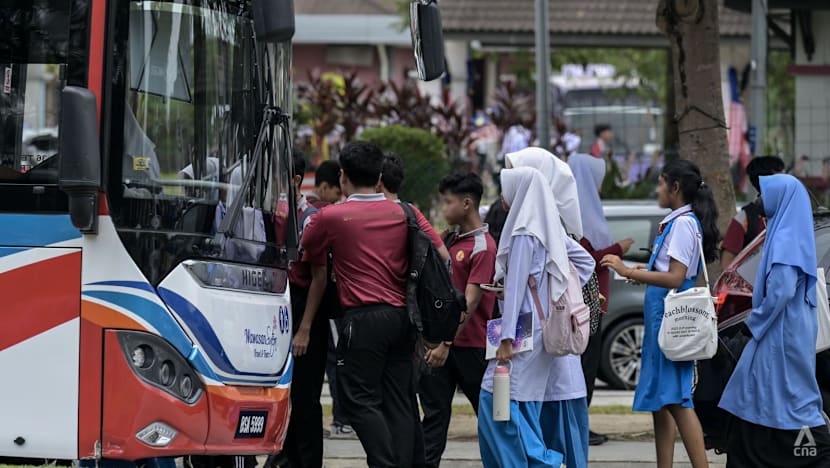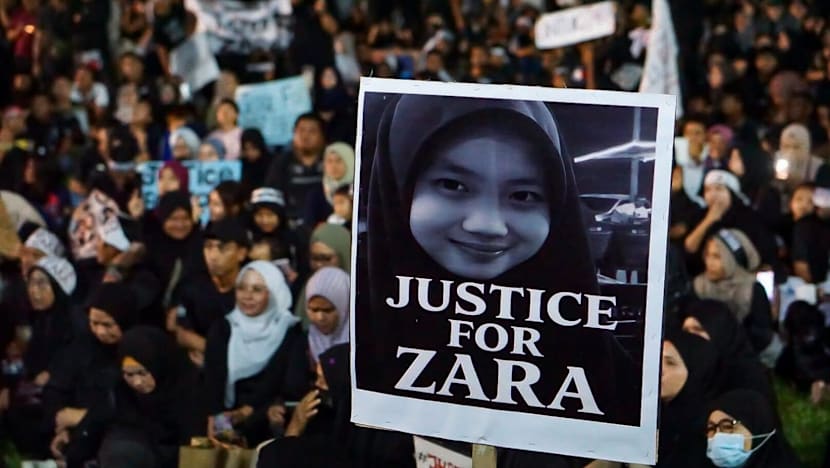Can Malaysia stop its school bullying scourge before it’s too late?
Experts say that laws are not the be-all and end-all when it comes to tackling bullying, and there is a need for a more holistic approach.

Students leaving a secondary school in Shah Alam, Selangor after classes ended for the day. (Photo: CNA/Fadza Ishak)

This audio is generated by an AI tool.
KUALA LUMPUR: Name-calling with racial slurs. Body shaming. Instances of being forced to carry another’s belongings.
These are just some of the examples of bullying cases that Farhana - a discipline teacher at a secondary school in Johor Bahru - has had to deal with among her students.
And while they may not appear to be as severe as those that have grabbed national headlines of late, Farhana - who wanted to be identified only by her first name - said that anecdotally, more students are now coming forward to the school’s counsellors to report cases of alleged bullying.
She added that this may be in part due to increased awareness over what constitutes bullying amid a call by Malaysia king Sultan Ibrahim Sultan Iskandar for the government to implement a comprehensive anti-bullying campaign to stop the scourge.
"We have always taken this issue seriously, but even more so with the recent cases," said Farhana.
According to data from Malaysia’s Ministry of Education, bullying cases have gone up every year since 2021, when 326 cases were reported then. The number then shot up to 3,887 cases in 2022, 6,528 cases in 2023 and 7,681 cases last year.
Malaysia - much like the rest of the world - was dealing with the COVID-19 pandemic in 2020 and 2021, where school closures and home-based learning were the norm then.
Education Minister Fadhlina Sidek said in a parliamentary reply on Aug 27 that of the cases reported in 2024, 5,689 cases involved secondary school students, while the remaining 1,992 of them involved primary school students.
She did not give a breakdown of previous year’s cases beyond the one in 2024.
Meanwhile, experts whom CNA spoke to have noticed a shift in bullying trends. While the problem was once more prevalent in universities and secondary schools, they said there is now anecdotal evidence that bullying is increasingly happening among younger students.
Rizan Hassan of Belia Mahir - a youth-focused initiative that seeks to empower young people through guidance and community involvement - posited that non-controlled exposure of children to social media, environmental influences and a "copycat" culture make it easy for them to imitate aggressive behaviour.
“This is worrying because that age is supposed to be a time for character and empathy development, but some are already being exposed to a toxic culture,” he told CNA, acknowledging that bullying is a global phenomenon.
While experts and child rights groups agree that bullying is a serious issue, they stress that the focus should be on prevention.
Lee Lyn-Ni, a child protection specialist at UNICEF Malaysia, told CNA that proposals for a special law or tribunal on bullying reflect public concerns on the matter, but laws on their own are not a solution.
Last month, de facto law minister Azalina Othman Said said that the Malaysian Cabinet was reviewing the possibility of a dedicated Anti-Bullying Act, including the establishment of a tribunal for cases involving children.
“Restorative approaches such as helping children understand the impact of their actions, repair harm, and build empathy, have been shown to be more effective than punitive measures in reducing bullying and creating safer schools,” said Lee.
“Because children are still developing, they may act impulsively or without fully realising the consequences. A balanced approach ensures that victims are protected while giving those who bully a chance to learn and change.”
SERIES OF HIGH-PROFILE CASES
Malaysia and the region have been rocked by a series of headline-grabbing school bullying cases since July, including that of Zara Qairina Mahathir, who was found unconscious after allegedly falling from the third floor of her dormitory on Jul 16.
The 13-year-old student from Sekolah Menengah Kebangsaan Agama Tun Datu Mustapha in Sabah was pronounced dead at a local hospital on Jul 17.
Zara’s death had sparked social media allegations of bullying, which garnered national attention for weeks through the hashtag #JusticeforZara.

It was then reported early last month that a 10-year-old student and cancer patient in Johor was allegedly bullied by his classmates on two separate occasions this year, requiring him to be hospitalised.
The student's mother shared the incidents on social media, leading to a public outcry and a police investigation.
And just last week, local media reported that a Form Three male student in Sabak Bernam, Selangor, is in critical condition after he fell from the third floor of his school’s dormitory building.
The boy’s parents have said that they suspected that their son - Ahmad Irfan Ahmad Hanafi - was a victim of bullying, although the Selangor police have said that it is still too early to determine whether the incident involves elements of bullying.
Experts whom CNA spoke to said that part of the increase in the number of bullying cases in Malaysia is due to increased awareness of the issue, as well as better reporting.
In 2022, the Ministry of Education launched an online portal - the Student Discipline Management System - where students or parents could file complaints of bullying in schools.
Fadhlina had said in her parliamentary reply that the system was updated with an anonymous reporting function to protect the identity of complainants and witnesses.

According to the Adolescent Health Survey 2022, which was conducted by Malaysia’s health ministry, around 8.6 per cent of 33,523 secondary school students from 239 schools nationwide surveyed reported that they had been bullied.
The most common forms of bullying included mocking someone's appearance (26.7 per cent), making sexual jokes or comments (16 per cent), intentionally excluding individuals from activities or ignoring them (13 per cent), ridiculing someone's race, nationality or colour (11.7 per cent), and other forms of bullying (20.2 per cent).
Ruhaishah Zulkifli, the communications officer of Kryss Network - an organisation that works on issues of freedom of opinion and expression - said that beyond the figures reported by the education ministry, which are concerning, there is still a gap in data in relation to bullying cases among students in institutions that are under statutory bodies as well as in private schools.
“The numbers are one thing, but even more worrying is the severity of the cases that we are seeing in Malaysia,” she told CNA, citing Zara’s case as an example.
Five teenage girls were charged last month with using abusive words against Zara, which were purportedly heard by her and caused distress.
The five have pleaded not guilty to one charge under Section 507C(1) of the Penal Code, which relates to the offence of using or making any threatening or abusive language or communication.
Ruhaishah said that oftentimes, victims of bullying are targeted because of their race, socio-economic backgrounds, as well as sexuality.
“From one of our interactions with a student, (he) mentioned that he was targeted by other boys as he is seen as more ‘effeminate’ and is friends with girls.
“Other students also mentioned that they are sometimes mocked on the basis of their (economic) class - where they are not able to buy new clothes compared to their friends who are more well-to-do,” she said.
Meanwhile, Rizan said that while bullying has long existed, widespread exposure and coverage on social media result in cases becoming public knowledge more quickly.
He also believed that the intensity and forms of bullying have also increased.
“It's not just physical but also involves psychological, mental, and even cyber aspects. This makes the impact on victims much more severe,” he told CNA.

PRIVATE TORMENT, PUBLIC SPECTACLE
Experts are particularly worried about a shift towards cyberbullying, saying that this new form of harassment can reach a far larger group of people than traditional bullying, turning private torment into a public spectacle.
Ruhaishah said that with the advancement of social media, technology and artificial intelligence (AI), children in primary schools are vulnerable to bullying not only in physical settings but on online platforms as well.
These, she said, include isolation on WhatsApp chat groups, name-calling or shaming online and in other severe instances, deepfakes.
The Adolescent Health Survey 2022 found that one in five adolescents in Malaysia has bullied or harassed someone online via the internet, cell phone, or other electronic devices.
The most prevalent forms of cyberbullying were making rude comments online (11.3 per cent) and spreading rumours about someone online (6.9 per cent).
Additionally, the survey found that a smaller percentage of adolescents have participated in other cyberbullying activities, such as sharing or posting embarrassing photos of others (4.8 per cent), making threatening comments to harm someone online (2 per cent), soliciting discussions about sex online (1.8 per cent) and urging others to engage in sexual activities online (1 per cent).
Ruhaishah told CNA that she is especially concerned with the use of AI - specifically deepfakes - against minors, pointing to a case at a private school in Johor where a student reportedly produced and sold such images of his female schoolmates and school alumni.
It was reported by The Star in April this year that 38 individuals had been identified as victims, with the youngest reportedly only 12 years old.
WHAT CAN BE DONE?
Experts say there is a need to move beyond blame to solutions, adding that the rights of children who are involved in bullying must also be upheld and that their actions be addressed through guidance and due process.
Andrew Mohanraj, the president of the Malaysian Mental Health Association, said that while a law or tribunal is necessary, there is concurrently a need to focus on a prevention-first approach that strengthens schools, parenting and focuses on digital safety.
He said that Japan, for instance, has a national Anti-Bullying Act that mandates every school to have anti-bullying policies, while Finland gives equal importance to prevention programmes in schools.
“Malaysia can adopt a combination of these approaches to suit our situation, needs and capacity. The time is now since you get students who are affected and online spaces have intensified risks,” said Mohanraj.
Last week, the Malaysian government announced that it has set up a special committee on bullying chaired by Azalina - the de facto law minister - to coordinate efforts across ministries.
Local media reported on Tuesday that the committee has met and reviewed a proposal to draft an Anti-Bullying Tribunal Bill on establishing a quasi-judicial body in Malaysia to handle such cases, in particular those that involve students and children.
Azalina's office said the meeting had focused on matters that include strengthening the existing legal framework by incorporating elements of rehabilitation and child protection, rather than focusing solely on punitive measures, as reported by the New Straits Times.
State news agency Bernama also reported on Wednesday that the Legal Affairs Division of the Prime Minister's Office headed by Azalina will be conducting a series of roadshows to gather public feedback on the proposed tribunal.
Meanwhile, Rizan said there is a need for a “holistic” approach where the school ecosystem is safe with “zero tolerance” against bullies. He said that while a special tribunal could be a crucial instrument to provide swift justice for victims, they could not solely rely on the law.
He said that in Finland and Norway, for instance, character education and emotional literacy are already implemented from a young age, with children taught to recognise emotions, manage anger, empathise, and respect others.
“Prevention, character education, and psychosocial support are equally important. The law provides enforcement, but education builds long-term change,” he said.
As for discipline teacher Farhana, she said that there are no easy fixes to solve the bullying issue as a whole and she could only hope that any complaints are nipped in the bud as early as possible.
"Most of the cases we see aren't as severe as what's in the news, but we know that if you don't take a complaint seriously, it can escalate into something much bigger," she warned.



















